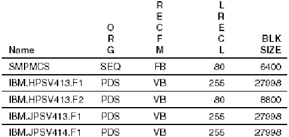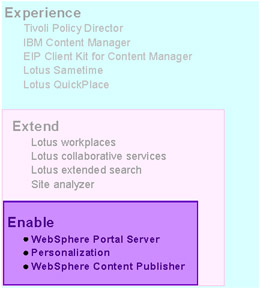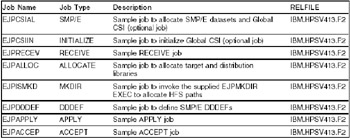2.4 SMPE installation
|
| < Day Day Up > |
|
2.4 SMP/E installation
WebSphere Portal for z/OS consists of WebSphere Portal Server Enable, WebSphere Transcoding Publisher, and WebSphere Portal Content Publishing. These products are delivered as an SMP/E installable component, each with its own separate FMID and COMPID as shown in Table 2-1.
| FMID | COMPID | Component name |
|---|---|---|
| HPSV413 | 5655K1200 | Portal server |
| JPSV413 | 5655K1201 | Transcoding publisher |
| JPSV414 | 5655K1202 | Content publisher |
SMP/E content description
WebSphere Portal for z/OS is packaged on a 3480 cartridge. The feature number is 5802 and is contained in one volume, with a VOLSER of PSV413. Figure 2-1 describes the program file content for Portal for z/OS.

Figure 2-1: Program file content
2.4.1 WebSphere Portal Server Enable offering for z/OS
WebSphere Portal Server for z/OS is the Enable version of the WebSphere Business Portal offerings that contains three modules as shown in Figure 2-2 on page 24:
-
WebSphere Portal Server
-
WebSphere Personalization
-
WebSphere Portal Content Publishing

Figure 2-2: WebSphere Portal Servers family
2.4.2 Prerequisites
The following list of software prerequisites must be installed and operational before proceeding with the Portal Server installation:
-
WebSphere Application Server must be current up to level UQ75293 (W401502), including all prerequisites.
-
The WebSphere Application Server installation must be verified by running the installation verification BBOIVPE.
-
A configured LDAP Server must be accessible.
-
The following Java version must be used: J2RE 1.3.1 IBM OS/390 Persistent Reusable VM build hm 131s-20021114a.
-
JDBC driver maintenance forward to PQ61146 and PTF UQ73041.
Maintenance considerations
Before performing the SMP/E installation steps, if you want to install Portal for z/OS to a different HFS than the default root HFS, you will need to create a new HFS file system. This new HFS has to be at least 600 cylinders in size as described in HOLD UA01959.
For our redbook project environment we decided to handle different versions of Portal for z/OS installations. To do that we used a /SERVICE directory to perform installation and maintenance of the application, and the default directory of /usr/lpp/PortalServer directory to install the current version of the product. We encourage you to do the same, so that you can easily maintain your Portal for z/OS installation.
In our case we used the following:
-
WPS.SERVICE.HFS was the file system mounted from /SERVICE/usr/lpp/PortalServer, where we performed installations and applied maintenance.
-
WPSPROD.HFS was the file system mounted from /usr/lpp/PortalServer where we ran Portal for z/OS.
| Note | The portal installation changes its own HFS and also modifies WebSphere for z/OS HFS files through SM API. Make sure that you follow the maintenance installation instructions and not just modifying the portal HFS files. |
| Important: | Ensure that the HFS file containing /tmp directory has at least 30 MB free space. |
SMP/E RECEIVE Jobs
Here are the SMP/E jobs used for the portal residency; you may need to customize the receive jobs so that they fit your specific environment:
Portal product SMP/E job
SMPRDAS1: This job does the receive of the Portal product and is shown in Example 2-1.
Example 2-1: Receive Portal Product
//SMPRDAS1 JOB (999,POK),'SMPEREC',CLASS=A,REGION=0M, // MSGCLASS=X,TIME=10,MSGLEVEL=(1,1),NOTIFY=&SYSUID //**************************************************************** //** THIS JOB DOES THE RECEIVE OF THE PORTAL PRODUCT FROM //* RELFILES ON DASD. //**************************************************************** //SMP EXEC PGM=GIMSMP,REGION=0K, SMPE // PARM='', // TIME=1000 //**************************************************************** //* SYSOUT DATA SETS //**************************************************************** //SMPPTFIN DD DISP=SHR,DSN=JAVA1.EJP.HPSV413.SMPMCS // DD DISP=SHR,DSN=JAVA1.EJP.JPSV413.SMPMCS // DD DISP=SHR,DSN=JAVA1.EJP.JPSV414.SMPMCS //SMPLOG DD SYSOUT=* //SMPLIST DD SYSOUT=* //SMPOUT DD SYSOUT=* //SMPRPT DD SYSOUT=* //SMPHOLD DD DUMMY //SYSUT1 DD DSN=&UT1,DISP=(NEW,PASS),UNIT=3390, // SPACE=(CYL,(40,10)),VOL=SER=TARTS1 //SYSUT2 DD DSN=&UT2,DISP=(NEW,PASS),UNIT=3390, // SPACE=(CYL,(40,10)),VOL=SER=TARTS1 //SYSUT3 DD DSN=&UT3,DISP=(NEW,PASS),UNIT=3390, // SPACE=(CYL,(40,10)),VOL=SER=TARTS1 //SYSUT4 DD DSN=&UT4,DISP=(NEW,PASS),UNIT=3390, // SPACE=(CYL,(40,10)),VOL=SER=TARTS1 //**************************************************************** //* SMP/E DATA SETS //**************************************************************** //SMPCSI DD DISP=SHR,DSN=WAS41.SMPE.CSI, // AMP='BUFNI=20,BUFND=20' //* //SMPCNTL DD * SET BDY(GLOBAL) . RECEIVE SELECT(HPSV413 JPSV413 JPSV414) SYSMODS LIST RFPREFIX(JAVA1) . /* //
Portal product maintenance SMP/E job
SMPRDAS2: This job does the receive of the Portal product PTFs and is shown in Example 2-2.
Example 2-2: Receive Portal Maintenance PTFs
//SMPRDAS2 JOB (999,POK),'SMPEREC',CLASS=A,REGION=0M, // MSGCLASS=X,TIME=10,MSGLEVEL=(1,1),NOTIFY=&SYSUID //**************************************************************** //** THIS JOB DOES THE RECEIVE OF THE PORTAL PRODUCT MAINTENANCE PTFs //* FROM RELFILES ON DASD. ****************************************************************** //SMP EXEC PGM=GIMSMP,REGION=0K, SMPE // PARM='', // TIME=1000 //**************************************************************** //* SYSOUT DATA SETS //**************************************************************** //SMPPTFIN DD DISP=SHR,DSN=JAVA1.UA01959 // DD DISP=SHR,DSN=JAVA1.UA01969 // DD DISP=SHR,DSN=JAVA1.UA01970 // DD DISP=SHR,DSN=JAVA1.UW95968 // DD DISP=SHR,DSN=JAVA1.UW95969 // DD DISP=SHR,DSN=JAVA1.UW95970 //SMPLOG DD SYSOUT=* //SMPLIST DD SYSOUT=* //SMPOUT DD SYSOUT=* //SMPRPT DD SYSOUT=* //SMPHOLD DD DUMMY //SYSUT1 DD DSN=&UT1,DISP=(NEW,PASS),UNIT=3390, // SPACE=(CYL,(40,10)),VOL=SER=TARTS1 //SYSUT2 DD DSN=&UT2,DISP=(NEW,PASS),UNIT=3390, // SPACE=(CYL,(40,10)),VOL=SER=TARTS1 //SYSUT3 DD DSN=&UT3,DISP=(NEW,PASS),UNIT=3390, // SPACE=(CYL,(40,10)),VOL=SER=TARTS1 //SYSUT4 DD DSN=&UT4,DISP=(NEW,PASS),UNIT=3390, // SPACE=(CYL,(40,10)),VOL=SER=TARTS1 //**************************************************************** //* SMP/E DATA SETS //**************************************************************** //SMPCSI DD DISP=SHR,DSN=WAS41.SMPE.CSI, // AMP='BUFNI=20,BUFND=20' //* //SMPCNTL DD * SET BDY(GLOBAL) . RECEIVE SYSMODS LIST .
Portal Product PTFs
Since this was a new installation we needed to install the Portal product base plus both PTFs:
-
PTF2 includes JAVA1.UA01959, JAVA1.UA01969, JAVA1.UA01970
-
PTF1 includes JAVA1.UW95968, JAVA1.UW95969, JAVA1.UW95970
2.4.3 UNICODE support
Before installing Portal for z/OS, you should ensure the system has UNICODE support installed. You can easily check for that by issuing TSO command (Example 2-3):
/D UNI,ALL
Example 2-3: Checking for UNICODE support
D UNI,ALL CUN3000I 18.53.15 UNI DISPLAY 301 ENVIRONMENT: CREATED 04/29/2003 AT 15.41.39 MODIFIED 04/29/2003 AT 15.41.40 IMAGE CREATED 04/29/2003 AT 15.12.57 SERVICE: CUNMCNV CUNMCASE STORAGE: ACTIVE 66 PAGES LIMIT 51200 PAGES CASECONV: NORMAL CONVERSION: 00850-01047-ER 01047-00850-ER
If you don't get the result shown in Example 2-3 on page 27 then you need to activate the conversion tables.
You will find a sample job for activating the conversion tables in Example 2-4.
Example 2-4: Conversion table sample job
//CUNIMAGE JOB (POK,999),'UNICODE',MSGLEVEL=(1,1),MSGCLASS=T, // CLASS=A,NOTIFY=&SYSUID //******************************************************************* //* IMAGE GENERATOR * //******************************************************************* //CUNMIUTL EXEC PGM=CUNMIUTL //STEPLIB DD DSN=SYS1.LINKLIB,DISP=SHR //SYSPRINT DD SYSOUT=* //TABIN DD DISP=SHR,DSN=SYS1.SCUNTBL //SYSIMG DD DSN=SYS1.PARMLIB(CUNIMG00),DISP=SHR //SYSIN DD * /******************************************** * INPUT STATEMENTS FOR THE IMAGE GENERATOR * ********************************************/ CASE NORMAL; /* ENABLE TOUPPER AND TOLOWER */ CONVERSION 00850,01047,ER; /*ASCII -> EBCDIC */ CONVERSION 01047,00850,ER; /*EBCDIC -> ASCII */ /* //
2.4.4 Performing the SMP/E installation
Portal for z/OS SMP/E installation comes with a set of jobs to perform the RECEIVE, APPLY, and ACCEPT commands. These jobs are located in the IBM.HPSV413.F2 dataset as described by Figure 2-3 on page 29.

Figure 2-3: List of installation jobs
Before modifying these jobs we copied them to a TSO JAVA1 userid JCL dataset called JAVA1.JCL.
SMP zone considerations
We decided to use the zone of WebSphere Application Server for z/OS to perform Portal for z/OS SMP/E installation. As dependencies existed only on the Application Server we considered this to be a good solution.
Before submitting the jobs, check to make sure that the following three F1 datasets are in the catalog. In a standard installation that would mean that the following datasets have to be cataloged:
-
IBM.HPSV413.F1
-
IBM.JPSV413.F1
-
IBM.JPSV414.F1
In our case the following datasets had been added to the catalog before performing the SMP/E RECEIVE:
-
JAVA1.EJP.HPSV413.F1
-
JAVA1.EJP.JPSV413.F1
-
JAVA1.EJP.JPSV414.F1
Allocate SMP/E target
Customize the allocation job EJPALLOC to make it match your specific requirements, for example: HLQ, VOLumes, and so on, as shown in Example 2-5 taken from our system:
Example 2-5: Allocate target
(...) //ALLOCT EXEC ALLOCTGT, // HLQ=WPS, * EJP is the default // DSP=CATLG, * CATLG is the default // TVOL1=WASTV1 * No default; volume1 for target libs //* //ALLOCD EXEC ALLOCDLB, // HLQ=WPS, * EJP is the default // DSP=CATLG, * CATLG is the default // DVOL=WASTV2 * No default; volume for dist. libs //* (...)
Create structure in target HFS
As mentioned in "Maintenance considerations" on page 24 we created a specific file system with a mountpoint to perform installation and apply maintenance. So the EJPISMKD job had to be tailored accordingly. Example 2-6 shows how we adapted the job for the maintenance process.
Example 2-6: Create HFS structure
//IKJEFT1A EXEC PGM=IKJEFT1A //SYSEXEC DD DISP=SHR, // DSN=WAS41.HPSV413.F2 //* //*SYSEXEC DD UNIT=SYSALLDA,VOL=SER=ttttt2,DISP=SHR, //* DSN=EJP.AEJPSAMP //* //SYSTSPRT DD SYSOUT=* //SYSTSIN DD * PROF MSGID EJPMKDIR /SERVICE
DDDEF entries
Now, customize job EJPDDDEF to make it match your specific requirements. Keep in mind that if you have chosen to follow our maintenance process you will have to tailor that job too, as shown in Example 2-7.
Example 2-7: Customize maintenance directory
(...) //DEFPATH EXEC PGM=GIMSMP,REGION=4096K //SMPCSI DD DSN=WAS41.SMPE.CSI, // DISP=SHR //SMPCNTL DD * SET BDY(WAST) . /* change -PathPrefix- */ ZONEEDIT DDDEF. CHANGE PATH('/usr/lpp/PortalServer'*, '/SERVICE/usr/lpp/PortalServer'*). ENDZONEEDIT. /*
Perform SMP/E APPLY and ACCEPT
Customize the APPLY and ACCEPT jobs, EJPAPPLY and EJPACCEP, to match your installation requirements. You can bypass the HODLDSYSTEM and get a return code of 0.
2.4.5 Post SMP/E installation
The post SMP/E installation steps turn out to be the real installation steps that you would normally have to do on a WebSphere Portal distributed platform.
| Note | The default path of WebSphere Portal, #WPS# for our installation, refers to /usr/lpp/PortalServer, and the #DRVNUM# refers to the driver number 4.1.2. You may use other values for #WPS# for your installation. |
After the SMP/E installation you should have six files in the directory you chose as the base #WPS# path. Table 2-2 shows the six files you should have. The three non version-suffixed files are the WebSphere Portal Server for z/OS three components at PTF1 level. The three files with 4.1.2 suffix are the PTF2 level of the three components.
| File name | File size | Component |
|---|---|---|
| ejppsrv.tar | 40826880 | Portal Server base PTF1 |
| ejppsrv.4.1.2.tar | 24432640 | Portal Server base PTF2 |
| ejpwcpub.tar | 11028480 | Content Publishing PTF1 |
| ejpwcpub.4.1.2.tar | 3317760 | Content Publishing PTF2 |
| ejppsrv.tar | 40826880 | Transcoding Publish. PTF1 |
| ejppsrv.4.1.2.tar | 24432640 | Transcoding Publish. PTF2 |
The actual process of installing PTF2 from scratch is different for each of the components as follows:
-
Portal Server base: PTF2 is an update to PTF1
-
Content Publishing: PTF2 is an update to PTF1
-
Transcoding Publisher: PTF2 is a full product replacement
This basically means that the next step will prepare installation for:
-
Portal Server base at PTF1 level full product
-
Portal Server base PTF2 level
-
Content Publishing at PTF1 level full product
-
Content Publishing PTF2 level
-
Transcoding Publisher at PTF2 level full product
|
| < Day Day Up > |
|